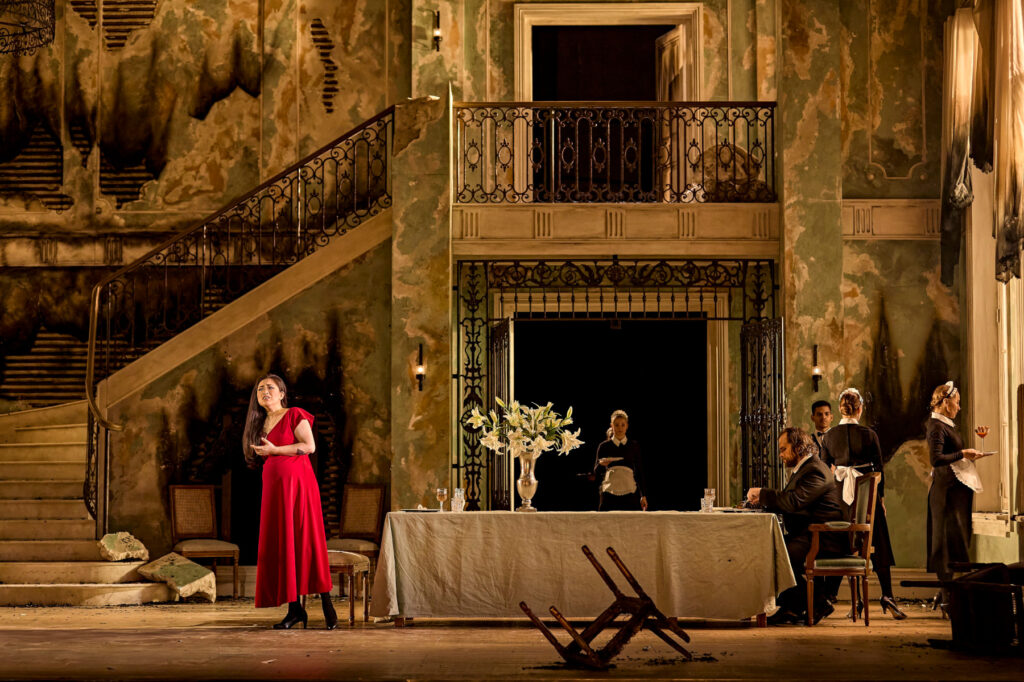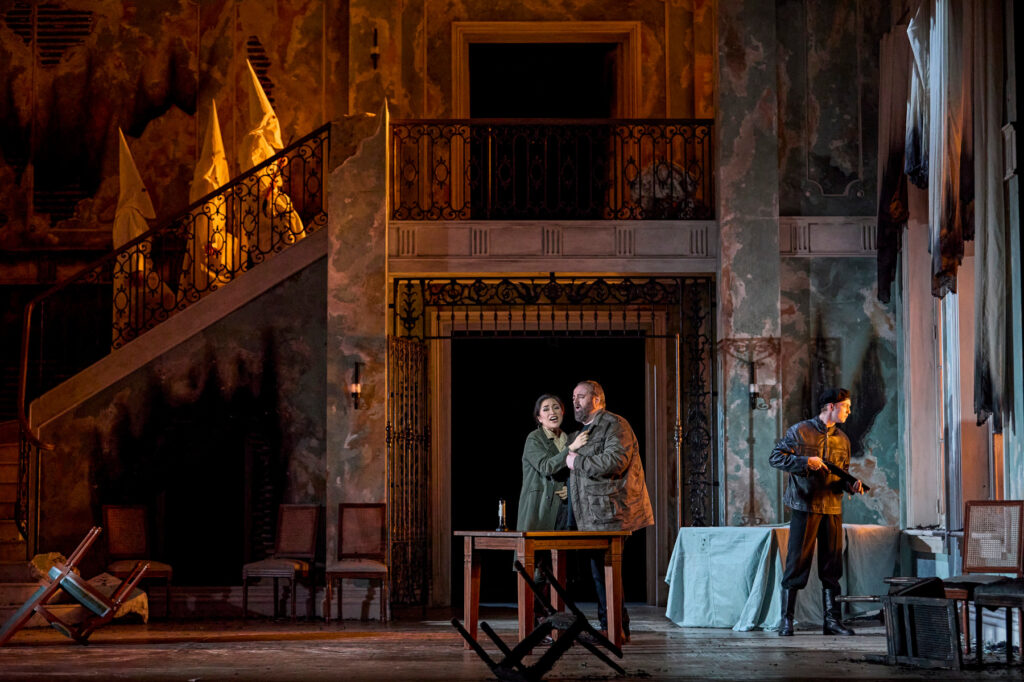Modern stage directors famously like to shake things up. Immo Karaman, directing Hamburg’s new production of Verdi’s Il Trovatore, has two guiding principles in the frame: this is an opera about conflict, both external and in the minds of the protagonists, and also about the traumatic consequences of fire and flames. When the many incidental details fail to cohere, however, the inevitable questions begin to arise.
The staging is relatively simple. Alex Eales’s uniform set depicts a ballroom in what looks like an Italian palazzo, with an ascending staircase complete with wrought-iron balustrades, marble effects and bleached tapestries, and an open window for entries and exits. This also serves as a backdrop for the gypsy encampment together with most of the scenes involving Azucena. The costumes designed by Herbert Barz-Murauer suggest a period around 1900; the large number of domestic servants attired in waitressing gear might well have come from any large regal hotel of that period. Though both Count di Luna and Manrico wield swords ahead of the off-stage duel, they also carry muskets, as do a number of other guerrilla-like operatives. The ravages of war are in evidence by the start of Part IV, with damaged ceilings, collapsed cornices and drapes torn and blackened by exploding munitions.
Another kind of war rages in the hearts and minds of two of the central characters. The gypsy Azucena is charged with avenging the death of her mother; she is equally tormented by the traumatic consequences of killing her own child. Luna is intent on eliminating Manrico, his sworn enemy in the armed civil conflict and also rival for the love of Leonora, as well as finding the person responsible for the killing of his own brother. The darkness inherent in such conflicts is emphasised in James Farncombe’s lighting: a fairly constant twilight with the addition of candelabra. The fire elements are limited to occasional video projections, a maid’s accidental self-immolation, and a burning vintage perambulator symbolising the deaths of Azucena’s mother at the stake and her own child. Joining up the dots of both the symbolism and the significance of the settings requires considerable effort.

It is when there are further unexpected twists in the plot that patience is severely tested. In Part III during Luna’s carousing with his troops he engages in a gratuitous and brutal rape of one of the female servants. If this was a deliberate attempt to deprive the audience of any remaining sympathies for Luna, it certainly worked. By the time Leonora reappears in Part IV she is heavily pregnant – again, at the hands of Luna? – and I found myself uncomfortably reminded of the exchanges between Scarpia and Tosca in Puccini’s opera as all the villainous threads in Luna’s character merged in his taunting of Leonora. The appearance of five figures looking like members of the Ku Klux Klan and processing up and down the staircase was one of many irritations. Right at the very end, after Luna has despatched Manrico with a musket and Azucena reveals to him that he has just killed his own brother, without a moment’s hesitation he turns the gun on himself. Macho types are not supposed to give up quite so easily.
Guanqun Yu was for me an ideal Leonora. Noble in bearing, she was the epitome of everything lyrical, secure in her accompanied coloratura runs – Verdi’s nod to Bellini – and firm in her chest register. Her Part I cavatina “Tacea la notte placido” where she confides her love for the Troubadour to Inez was coated in velvety tones. Her Part IV aria “D’amor sull’ ali rosee”, when she knows that the poison she has taken is robbing her of all forbearance, was full of poignancy and sadness.

At the outset there was a touch of huskiness in the Azucena of Elena Maximova, but her deep chest tones were most impressive, not least in “Stride la vampa!” where she conveyed the hallucinatory and unsettling qualities of what her memory has drudged up. Tenderness was there when she sings to Manrico of his grandmother and also, as the opera draws to a close, in their duet “Ai nostri monti” with her delirious yearning for an idyllic rural existence.
Both Aleksei Isaev as Luna and Gwyn Hughes Jones looked like the brothers they turned out to be. That helped, though at times it was like being reminded of that primordial distinction between Cain and Abel. I’m not sure it helps the complexity of the character Luna that it was played and often sung with a measure of malevolence. Nonetheless, in the glowing lower reaches of his baritonal range Isaev displayed all his inflamed passion most effectively.
It was Caruso who stated that all you need for Il Trovatore are the four greatest singers in the world. Sadly, there was one weak link and this was the Manrico of Gwyn Hughes Jones. For the role of the Troubadour a sweet-toned lyrical tenor is essential, a capacity to soar and entrance with the beauty of the voice. Hughes Jones was happiest in his middle register and in pianissimo passages, but elsewhere there were signs of vocal fraying, the transitions were never as seamless as required, and he struggled with his high Cs.
Alexander Roslavets’s Ferrando was a particular delight. To him falls the major part of narration and in this bass role he delivered all the drama and tragedy of the back story with weight and authority.
The chorus were unfailingly focused and lusty, especially in the “Coro di Zingari e Canzone” that opens Part II. The work as a whole is known as a singers’ opera, but without adequate support from the pit it can easily come adrift. The Milanese Giampaolo Bisanti, currently in charge of the Royal Opera in Liège, took great care never to cover his leading voices, and with supple rhythms and warm playing from his orchestra contributed to a satisfying feeling of italianità.
Performances run until 9th April 2024
Alexander Hall
Il Trovatore
Music by Giuseppe Verdi
Libretto by Salvadore Cammarano/Leone Emanuele Bardare
Count di Luna – Aleksei Isaev, Manrico – Gwyn Hughes Jones, Azucena – Elena Maximova, Leonora – Guanqun Yu, Ferrando – Alexander Roslavets, Inez – Olivia Boen, Ruiz – Aaron Godfrey-Mayes, An old man – Eun-Seok Jang, Director – Immo Karaman, Designer – Alex Eales, Costumes – Herbert Barz-Murauer, Lighting – James Farncombe, Video – Philipp Contag-Lada, Dramaturgy – Ralf Waldschmidt, Choreography – Fabian Posca, Chorus of Staatsoper Hamburg (Christian Günther, Chorus Director), Hamburg State Philharmonic Orchestra (Conductor, Giampaolo Bisanti)
Staatsoper Hamburg, Sunday 17 March 2024
Top Image: Gwyn Hughes Jones (Manrico) with Elena Maximova (Azucena)
All photos © Brinkhoff/Mögenburg